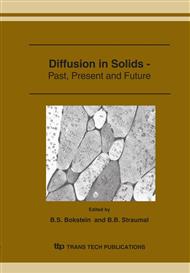p.231
p.235
p.239
p.247
p.255
p.263
p.269
p.275
p.281
Effect of Mechanoactivation on Interfacial Interaction in Metal/Oxide Systems
Abstract:
Properties of interfaces in solid state metal/oxide joints (Al/SiO2, Al/MgO, Al/glass, Mg/MgO, Mg/SiO2, In/glass etc.) are reported. The interfaces were formed by plastic deformation of metal on the oxide surface at room temperature. Their structure, chemical composition, and micromechanical properties were studied by the AFM, XRD, SIMS, optical microscopy, and precision microindentation techniques. A noticeable adhesion was observed for metals with high affinity for oxygen and only in the regions of the maximum shear stress. Formation of an interfacial reaction zone with an oxygen concentration gradient is detected. In this zone metals are nanostructured and noticeably hardened. The effect of mechanoactivation is considered as a result of physical and chemical interaction and formation of nanostructures in deformed metal/oxide systems.
Info:
Periodical:
Pages:
263-268
Citation:
Online since:
January 2006
Authors:
Price:
Сopyright:
© 2006 Trans Tech Publications Ltd. All Rights Reserved
Share:
Citation:


